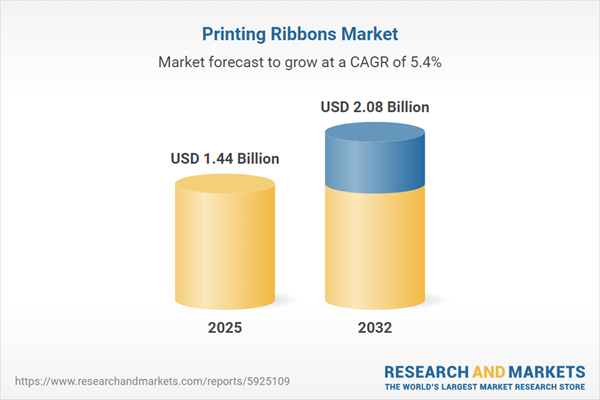Speak directly to the analyst to clarify any post sales queries you may have.
The printing ribbons market is evolving rapidly, shaped by advancements in materials, sustainability initiatives, and changing end-user requirements. Senior executives navigating supply chain and procurement decisions can leverage nuanced analysis for precise, future-ready strategic planning.
Market Snapshot: Printing Ribbons Market Size and Growth Trends
The printing ribbons market grew from USD 1.37 billion in 2024 to USD 1.44 billion in 2025. The market is projected to expand steadily at a CAGR of 5.38%, ultimately reaching USD 2.08 billion by 2032. Robust demand drivers include increased labeling and traceability requirements, convergence of digital and material technologies, and the adoption of eco-friendly printing solutions across sectors.
Scope & Comprehensive Segmentation
This report offers an actionable breakdown across applications, product formulations, end-use industries, printer compatibility, and global regions:
- Applications: Barcode, logistics, retail, corrugated carton, flexible packaging, shrink sleeve, apparel tags, and garment marking
- Product Types: Resin (including high temperature and metallic types), wax (general purpose, premium), standard wax resin blends
- End Use Industries: Healthcare (laboratory, pharma), manufacturing (automotive, electronics), retail, transportation, logistics
- Printer Types: Desktop (entry level, mid-range), industrial (heavy duty, high volume), mobile (portable)
- Regions: Americas (United States, Canada, Mexico, Brazil, Argentina, Chile, Colombia, Peru), Europe (UK, Germany, France, Russia, Italy, Spain, Netherlands, Sweden, Poland, Switzerland), Middle East (UAE, Saudi Arabia, Qatar, Turkey, Israel), Africa (South Africa, Nigeria, Egypt, Kenya), Asia-Pacific (China, India, Japan, Australia, South Korea, Indonesia, Thailand, Malaysia, Singapore, Taiwan)
- Companies Profiled: Zebra Technologies Corporation, Dai Nippon Printing Co., Ltd., Fujifilm Holdings Corporation, Avery Dennison Corporation, Seiko Epson Corporation, Toshiba Tec Corporation, Honeywell International Inc., SATO Holdings Corporation, Brady Corporation, HP Inc.
Key Takeaways: Strategic Insights for Senior Decision-Makers
- Thermal transfer and direct thermal technologies remain central to industrial and retail traceability, prompting ongoing material and formulation innovation.
- Sustainable printing solutions are influencing procurement, with rising adoption of recyclable substrates and bio-based waxes.
- Segmented applications such as high-temperature manufacturing, retail labeling, and forensic-grade healthcare marking necessitate specialized ribbon chemistry.
- Printer OEM and ribbon supplier collaborations are enhancing integration between hardware and consumables, optimizing user experience and operational efficiency.
- Mid-tier suppliers are differentiating by offering tailored solutions and agile prototyping for niche or fast-evolving use cases.
- Consolidation among vendors and upstream raw material integration are shaping competitive strategies and improving supply chain resilience.
Tariff Impact on Supply Chain and Pricing Dynamics
Recent United States tariff introductions have contributed to increased costs and sourcing complexities for specialty resins and waxes. Market participants are responding by diversifying supply bases and revisiting inventory strategies to limit exposure. Enhanced regional procurement, just-in-time replenishment, and flexible contracting are emerging as best practices, securing business continuity amid regulatory changes.
Methodology & Data Sources
Analysis stems from a hybrid research approach blending in-depth executive interviews, end-user surveys, and systematic secondary sourcing across trade literature, regulatory findings, and corporate disclosures. Cross-validation and scenario planning underpin the credibility of insight delivered, with special attention to evolving application preferences and supply chain pressures.
Why This Report Matters: Value for Leaders
- Identify growth opportunities and emerging risks across key regions and verticals with comprehensive segmentation and qualitative context for each application.
- Make informed procurement and product development decisions with clarity on technology trends, sustainability standards, and regulatory factors.
- Strengthen business resilience by leveraging data-driven insights on competitive movements, supply chain shifts, and evolving end-user demands.
Conclusion
The printing ribbons market is advancing alongside shifts in technology, materials, and regulatory landscapes. This report equips senior decision-makers with actionable segmentation, insightful trends, and supply chain intelligence essential for sustainable and competitive growth.
Additional Product Information:
- Purchase of this report includes 1 year online access with quarterly updates.
- This report can be updated on request. Please contact our Customer Experience team using the Ask a Question widget on our website.
Table of Contents
3. Executive Summary
4. Market Overview
7. Cumulative Impact of Artificial Intelligence 2025
Companies Mentioned
The companies profiled in this Printing Ribbons market report include:- Zebra Technologies Corporation
- Dai Nippon Printing Co., Ltd.
- Fujifilm Holdings Corporation
- Avery Dennison Corporation
- Seiko Epson Corporation
- Toshiba Tec Corporation
- Honeywell International Inc.
- SATO Holdings Corporation
- Brady Corporation
- HP Inc.
Table Information
| Report Attribute | Details |
|---|---|
| No. of Pages | 192 |
| Published | October 2025 |
| Forecast Period | 2025 - 2032 |
| Estimated Market Value ( USD | $ 1.44 Billion |
| Forecasted Market Value ( USD | $ 2.08 Billion |
| Compound Annual Growth Rate | 5.3% |
| Regions Covered | Global |
| No. of Companies Mentioned | 11 |









